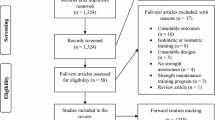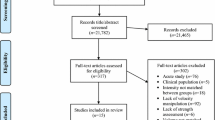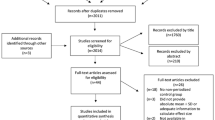Abstract
Background
Rest interval (RI) duration is an important resistance-training variable underlying gain in muscular strength. Recommendations for optimal RI duration for gains in muscular strength are largely inferred from studies examining the acute resistance training effects, and the generalizability of such findings to chronic adaptations is uncertain.
Objective
The goals of this systematic literature review are: (i) to aggregate findings and interpret the studies that assessed chronic muscular strength adaptations to resistance training interventions involving different RI durations, and (ii) to provide evidence-based recommendations for exercise practitioners and athletes.
Methods
The review was performed according to the PRISMA guidelines with a literature search encompassing five databases. Methodological quality of the studies was evaluated using a modified version of the Downs and Black checklist.
Results
Twenty-three studies comprising a total of 491 participants (413 males and 78 females) were found to meet the inclusion criteria. All studies were classified as being of good to moderate methodological quality; none of the studies were of poor methodological quality.
Conclusion
The current literature shows that robust gains in muscular strength can be achieved even with short RIs (< 60 s). However, it seems that longer duration RIs (> 2 min) are required to maximize strength gains in resistance-trained individuals. With regard to untrained individuals, it seems that short to moderate RIs (60–120 s) are sufficient for maximizing muscular strength gains.

Similar content being viewed by others
References
Moritani T, deVries HA. Neural factors versus hypertrophy in the time course of muscle strength gain. Am J Phys Med. 1979;58(3):115–30.
Suchomel TJ, Nimphius S, Stone MH. The importance of muscular strength in athletic performance. Sports Med. 2016;46(10):1419–49.
Hunter GR, McCarthy JP, Bamman MM. Effects of resistance training on older adults. Sports Med. 2004;34(5):329–48.
Cheema BS, Chan D, Fahey P, et al. Effect of progressive resistance training on measures of skeletal muscle hypertrophy, muscular strength and health-related quality of life in patients with chronic kidney disease: a systematic review and meta-analysis. Sports Med. 2014;44(8):1125–38.
Schranz N, Tomkinson G, Olds T. What is the effect of resistance training on the strength, body composition and psychosocial status of overweight and obese children and adolescents? A systematic review and meta-analysis. Sports Med. 2013;43(9):893–907.
Baechle TR, Earle RW. Essentials of strength training and conditioning. 2nd ed. Champaign: Human Kinetics; 2000.
Kraemer WJ, Noble BJ, Clark MJ, et al. Physiologic responses to heavy-resistance exercise with very short rest periods. Int J Sports Med. 1987;8(4):247–52.
McKendry J, Pérez-López A, McLeod M, et al. Short inter-set rest blunts resistance exercise-induced increases in myofibrillar protein synthesis and intracellular signalling in young males. Exp Physiol. 2016;101(7):866–82.
Kraemer WJ, Ratamess NA. Hormonal responses and adaptations to resistance exercise and training. Sports Med. 2005;35(4):339–61.
Ratamess NA, Falvo MJ, Mangine GT, et al. The effect of rest interval length on metabolic responses to the bench press exercise. Eur J Appl Physiol. 2007;100(1):1–17.
Gonzalez AM. Effect of interset rest interval length on resistance exercise performance and muscular adaptation. Strength Cond J. 2016;38(6):65–8.
Abdessemed D, Duche P, Hautier C, et al. Effect of recovery duration on muscular power and blood lactate during the bench press exercise. Int J Sports Med. 1999;20(6):368–73.
Schoenfeld BJ. The mechanisms of muscle hypertrophy and their application to resistance training. J Strength Cond Res. 2010;24(10):2857–72.
American College of Sports Medicine. American college of sports medicine position stand. Progression models in resistance training for healthy adults. Med Sci Sports Exerc. 2009;41(3):687–708.
Borde R, Hortobágyi T, Granacher U. Dose–response relationships of resistance training in healthy old adults: a systematic review and meta-analysis. Sports Med. 2015;45(12):1693–720.
Burns PB, Rohrich RJ, Chung KC. The levels of evidence and their role in evidence-based medicine. Plast Reconstr Surg. 2011;128(1):305–10.
de Salles BF, Simão R, Miranda F, et al. Rest interval between sets in strength training. Sports Med. 2009;39(9):765–77.
Richmond SR, Godard MP. The effects of varied rest periods between sets to failure using the bench press in recreationally trained men. J Strength Cond Res. 2004;18(4):846–9.
Gentil P, Bottaro M, Oliveira E, et al. Chronic effects of different between-set rest durations on muscle strength in nonresistance trained young men. J Strength Cond Res. 2010;24(1):37–42.
Villanueva MG, Lane CJ, Schroeder ET. Short rest interval lengths between sets optimally enhance body composition and performance with 8 weeks of strength resistance training in older men. Eur J Appl Physiol. 2015;115(2):295–308.
Schoenfeld BJ, Pope ZK, Benik FM, et al. Longer interset rest periods enhance muscle strength and hypertrophy in resistance-trained men. J Strength Cond Res. 2016;30(7):1805–12.
de Salles BF, Simão R, Miranda H, et al. Strength increases in upper and lower body are larger with longer inter-set rest intervals in trained men. J Sci Med Sport. 2010;13(4):429–33.
Buresh R, Berg K, French J. The effect of resistive exercise rest interval on hormonal response, strength, and hypertrophy with training. J Strength Cond Res. 2009;23(1):62–71.
Moher D, Liberati A, Tetzlaff J, et al. Preferred reporting items for systematic reviews and meta-analyses: the PRISMA statement. PLoS Med. 2009;6(7):e1000097.
Warren GL, Park ND, Maresca RD, et al. Effect of caffeine ingestion on muscular strength and endurance: a meta-analysis. Med Sci Sports Exerc. 2010;42(7):1375–87.
Grgic J, Lazinica B, Mikulic P, et al. Effect of short versus long inter-set rest intervals on measures of muscle hypertrophy: a systematic review. Eur J Sport Sci. 2017;17(8):983–93.
Downs SH, Black N. The feasibility of creating a checklist for the assessment of the methodological quality both of randomised and non-randomised studies of health care interventions. J Epidemiol Community Health. 1998;52(6):377–84.
Davies T, Orr R, Halaki M, et al. Effect of training leading to repetition failure on muscular strength: a systematic review and meta-analysis. Sports Med. 2016;46(4):487–502.
Robinson JM, Stone MH, Johnson RL, et al. Effects of different weight training exercise/rest intervals on strength, power, and high intensity exercise endurance. J Strength Cond Res. 1995;9(4):216–21.
Hill-Haas S, Bishop D, Dawson B, et al. Effects of rest interval during high-repetition resistance training on strength, aerobic fitness, and repeated-sprint ability. J Sports Sci. 2007;25(6):619–28.
Willardson JM, Burkett LN. The effect of different rest intervals between sets on volume components and strength gains. J Strength Cond Res. 2008;22(1):146–52.
Ahtiainen JP, Pakarinen A, Alen M, et al. Short vs. long rest period between the sets in hypertrophic resistance training: influence on muscle strength, size, and hormonal adaptations in trained men. J Strength Cond Res. 2005;19(3):572–82.
Fink JE, Schoenfeld BJ, Kikuchi N, et al. Acute and long-term responses to different rest intervals in low-load resistance training. Int J Sports Med. 2017;38(2):118–24.
de Souza TP Jr, Fleck SJ, Simão R, et al. Comparison between constant and decreasing rest intervals: influence on maximal strength and hypertrophy. J Strength Cond Res. 2010;24(7):1843–50.
de Souza TP Jr, Willardson JM, Bloomer R, et al. Strength and hypertrophy responses to constant and decreasing rest intervals in trained men using creatine supplementation. J Int Soc Sports Nutr. 2011;8(1):17.
Jambassi Filho JC, Gurjão AL, Ceccato M, et al. Chronic effects of different rest intervals between sets on dynamic and isometric muscle strength and muscle activity in trained older women. Am J Phys Med Rehabil. 2017;96(9):627–33.
Pincivero DM, Lephart SM, Karunakara RG. Effects of rest interval on isokinetic strength and functional performance after short-term high intensity training. Br J Sports Med. 1997;31(3):229–34.
Pincivero DM, Campy RM. The effects of rest interval length and training on quadriceps femoris muscle, part I: knee extensor torque and muscle fatigue. J Sports Med Phys Fitness. 2004;44(2):111–8.
Garcıa-Lopez D, De Paz JA, Moneo E, et al. Effects of short vs long rest period between sets on elbow-flexor muscular endurance during resistance training to failure. J Strength Cond Res. 2007;21(4):1320–4.
Piirainen JM, Tanskanen M, Nissilä J, et al. Effects of a heart rate-based recovery period on hormonal, neuromuscular, and aerobic performance responses during 7 weeks of strength training in men. J Strength Cond Res. 2011;25(8):2265–73.
Simão R, Polito M, Miranda H, et al. Analysis of different rest intervals between sets in strength training program. Fit Perf J. 2006;5(5):290–4.
Mohamadimofrad A, Nikbakht M, Habibi A, et al. Comparison of 3 different rest times in resistance training plan of footballers maximum power in leg squat and bench press. Life Sci J. 2013;10(7):528–33.
Cassetty JL. Comparison of 30 and 60 second rest periods between sets of a resistance training program. Masters thesis, Oklahoma State University. 2000.
Holmes CJ. The effects of rest period lengths on muscle hypertrophy and intra-exercise performance. Masters thesis, University of Central Missouri. 2016.
Peers DH. Differing rest intervals: Effect on recovery heart rate and strength. Masters thesis, Lamar University. 2013.
Reed BL. Comparison of 30 and 90 second rest periods between sets of a resistance training program. Masters thesis, Oklahoma State University. 1998.
Gentil P, Arruda A, Souza D, et al. Is there any practical application of meta-analytical results in strength training? Front Physiol. 2017;8:1.
Ralston GW, Kilgore L, Wyatt FB, et al. The effect of weekly set volume on strength gain: a meta-analysis. Sports Med. 2017. doi:10.1007/s40279-017-0762-7.
Willardson JM. A brief review: how much rest between sets? Strength Cond J. 2008;30(3):44–50.
Hubal MJ, Gordish-Dressman H, Thompson PD, et al. Variability in muscle size and strength gain after unilateral resistance training. Med Sci Sports Exerc. 2005;37(6):964–72.
Theou O, Gareth JR, Brown LE. Effect of rest interval on strength recovery in young and old women. J Strength Cond Res. 2008;22(6):1876–81.
Kraemer WJ, Ratamess NA, Fry AC, et al. Strength testing: development and evaluation of methodology. In: Maud PJ, Champaign FC, editors. Physiological assessment of human fitness. Champaign: Human Kinetics; 2006. p. 119–50.
Garber CE, Blissmer B, Deschenes MR, et al. American College of Sports Medicine position stand, Quantity and quality of exercise for developing and maintaining cardiorespiratory, musculoskeletal, and neuromotor fitness in apparently healthy adults: guidance for prescribing exercise. Med Sci Sports Exerc. 2011;43(7):1334–59.
Bennie JA, Pedisic Z, van Uffelen JG, et al. Pumping iron in Australia: prevalence, trends and sociodemographic correlates of muscle strengthening activity participation from a national sample of 195,926 adults. PLoS ONE. 2016;11(4):e0153225.
Loustalot F, Carlson SA, Kruger J, et al. Muscle-strengthening activities and participation among adults in the United States. Res Q Exerc Sport. 2013;84(1):30–8.
Celes R, Brown LE, Pereira MC, et al. Gender muscle recovery during isokinetic exercise. Int J Sports Med. 2010;31(12):866–9.
Hunter SK. Sex differences in human fatigability: mechanisms and insight to physiological responses. Acta Physiol. 2014;210(4):768–89.
Tan B. Manipulating resistance training program variables to optimize maximum strength in men: a review. J Strength Cond Res. 1999;13(3):289–304.
Schoenfeld BJ, Wilson JM, Lowery RP, et al. Muscular adaptations in low- versus high-load resistance training: a meta-analysis. Eur J Sport Sci. 2016;16(1):1–10.
Schoenfeld BJ, Grgic J, Ogborn D, et al. Strength and hypertrophy adaptations between low- versus high-load resistance training: A systematic review and meta-analysis. J Strength Cond Res. 2017. doi:10.1519/JSC.0000000000002200.
Rooney KJ, Herbert RD, Balnave RJ. Fatigue contributes to the strength training stimulus. Med Sci Sports Exerc. 1994;26(9):1160–4.
Lawton T, Cronin J, Drinkwater E, et al. The effect of continuous repetition training and intra-set rest training on bench press strength and power. J Sports Med Phys Fitness. 2004;44(4):361–7.
Sampson JA, Groeller H. Is repetition failure critical for the development of muscle hypertrophy and strength? Scand J Med Sci Sports. 2016;26(4):375–83.
Wernbom M, Augustsson J, Thomeé R. The influence of frequency, intensity, volume and mode of strength training on whole muscle cross-sectional area in humans. Sports Med. 2007;37(3):225–64.
Steele J, Fisher J, Giessing J, et al. Clarity in reporting terminology and definitions of set endpoints in resistance training. Muscle Nerve. 2017;56(3):368–74.
Figueiredo T, Willardson JM, Miranda H, et al. Influence of rest interval length between sets on blood pressure and heart rate variability after a strength training session performed by prehypertensive men. J Strength Cond Res. 2016;30(7):1813–24.
Author information
Authors and Affiliations
Corresponding author
Ethics declarations
Conflicts of Interest
Jozo Grgic, Brad J. Schoenfeld, Mislav Skrepnik, Timothy B. Davies, and Pavle Mikulic declare that they have no conflicts of interest relevant to the content of this review.
Funding
No external sources of funding were used to assist in the preparation of this article.
Rights and permissions
About this article
Cite this article
Grgic, J., Schoenfeld, B.J., Skrepnik, M. et al. Effects of Rest Interval Duration in Resistance Training on Measures of Muscular Strength: A Systematic Review. Sports Med 48, 137–151 (2018). https://doi.org/10.1007/s40279-017-0788-x
Published:
Issue Date:
DOI: https://doi.org/10.1007/s40279-017-0788-x




